|
5月16日,王秀芹、刘文凤老师在博文楼英语教科室进行了教学成果展示,两位老师都有30多年教学实践,积累了丰富的教学经验,令听者获益颇丰。
下面是论坛活动的照片、ppt,请大家学习欣赏。
一、照片
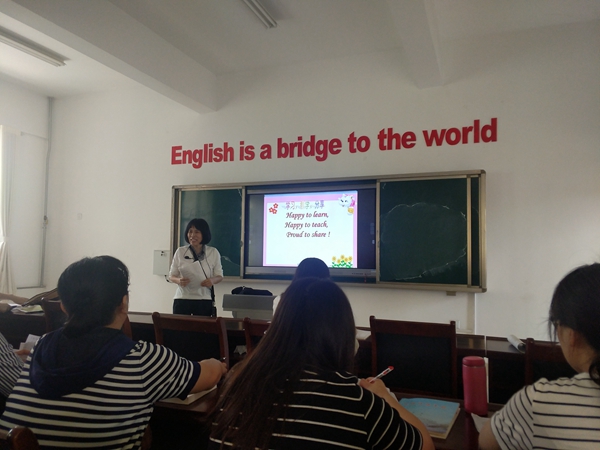
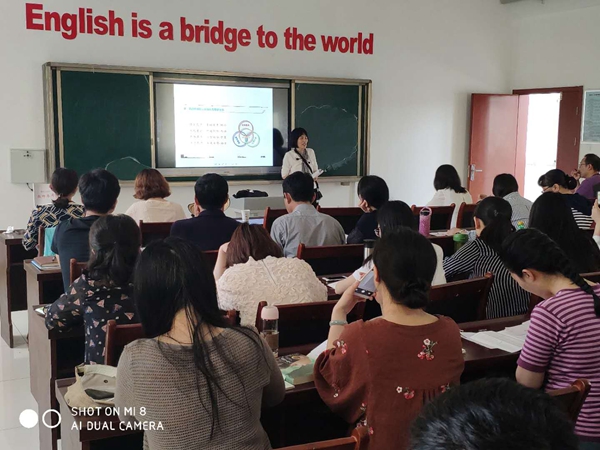
二、图片欣赏


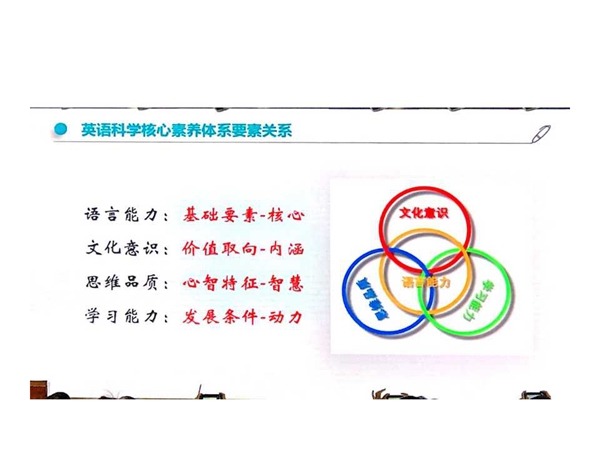
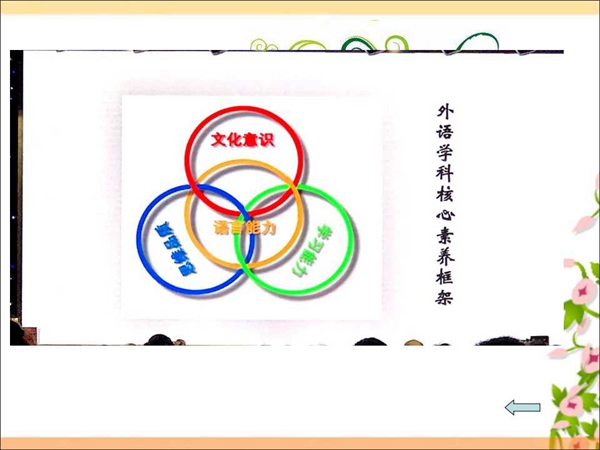
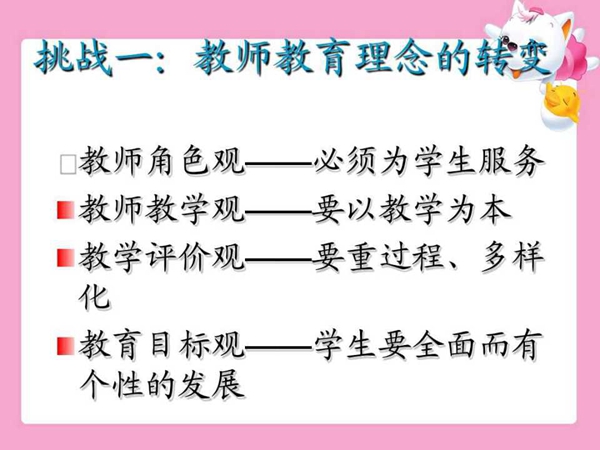
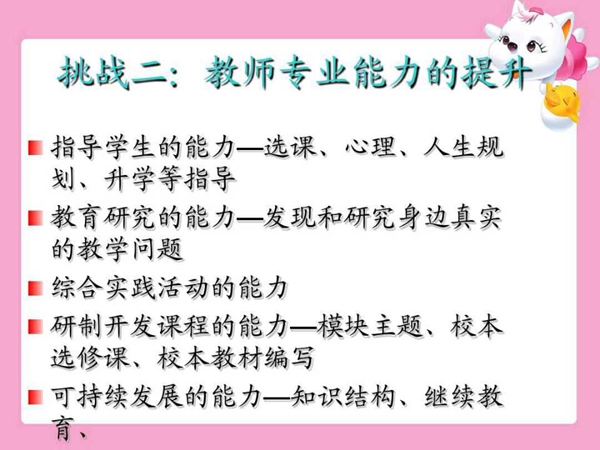
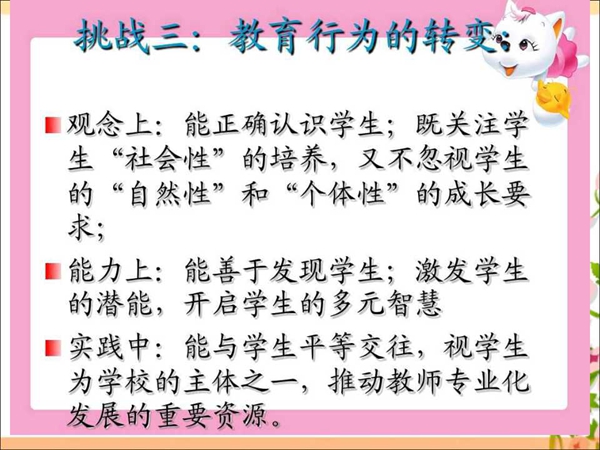

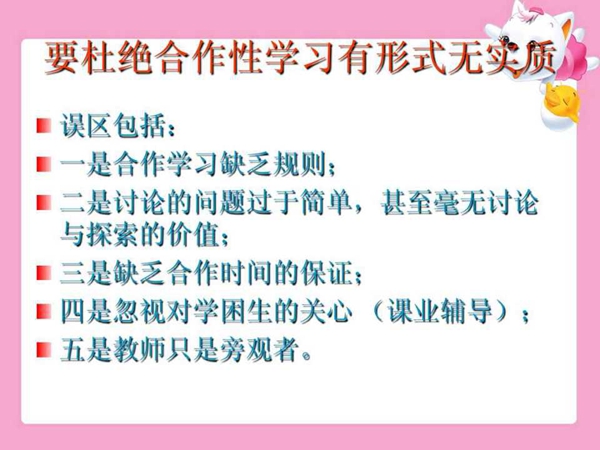
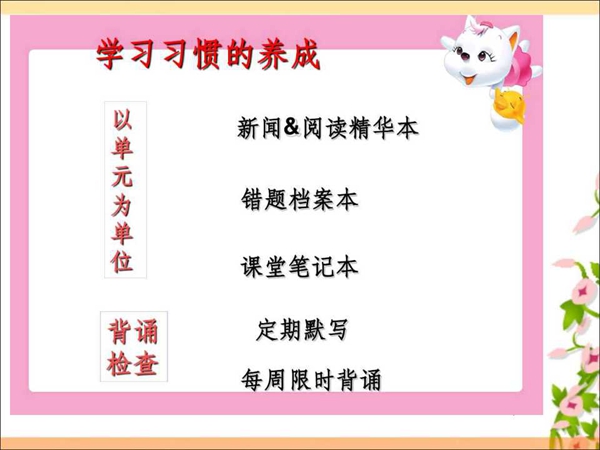
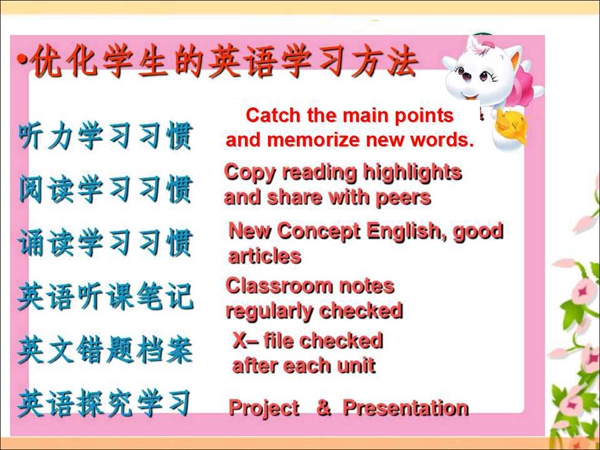

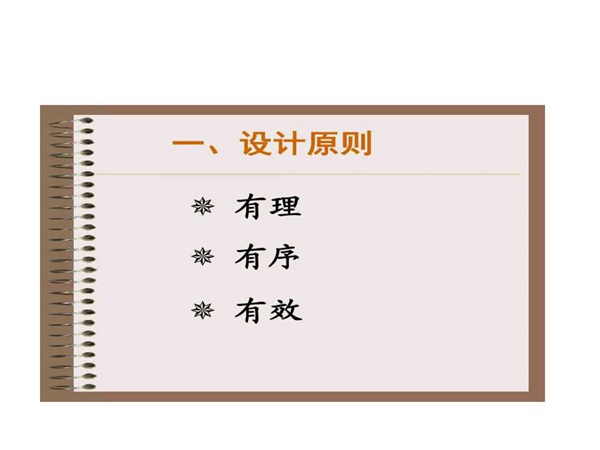
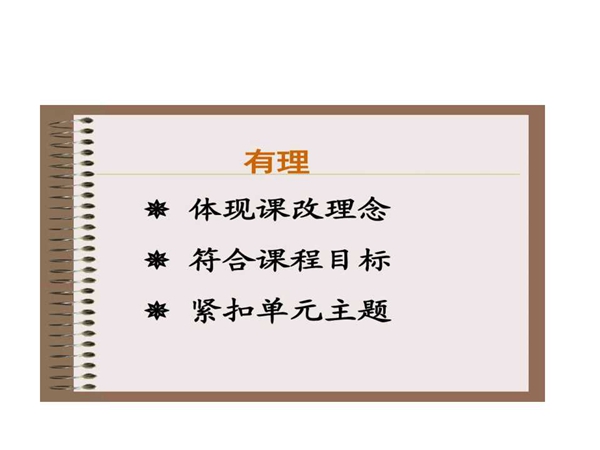
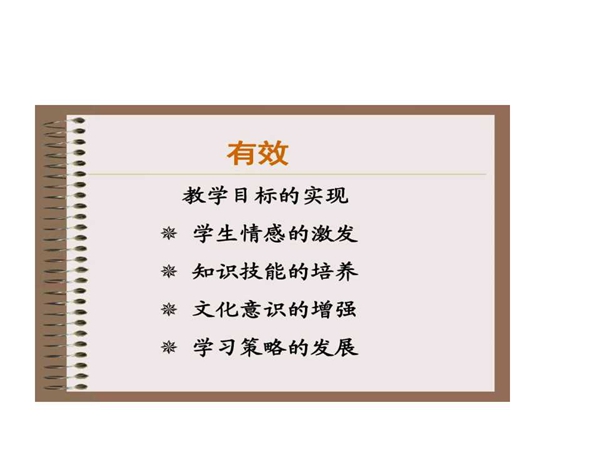
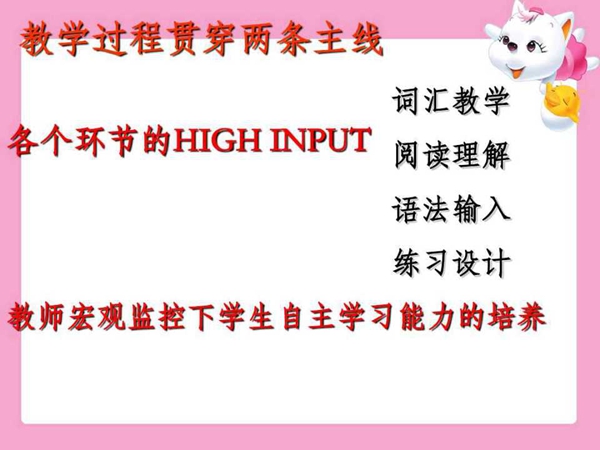
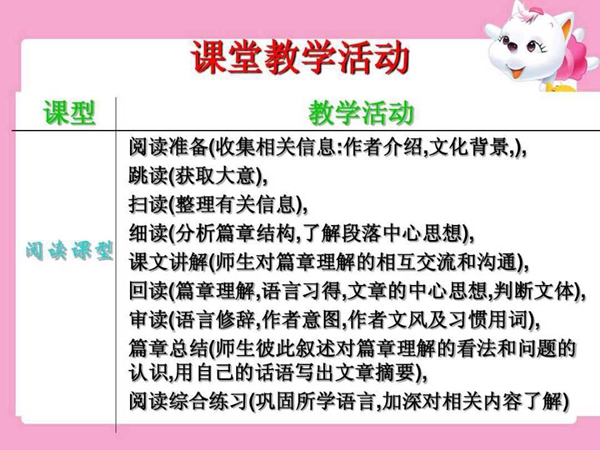
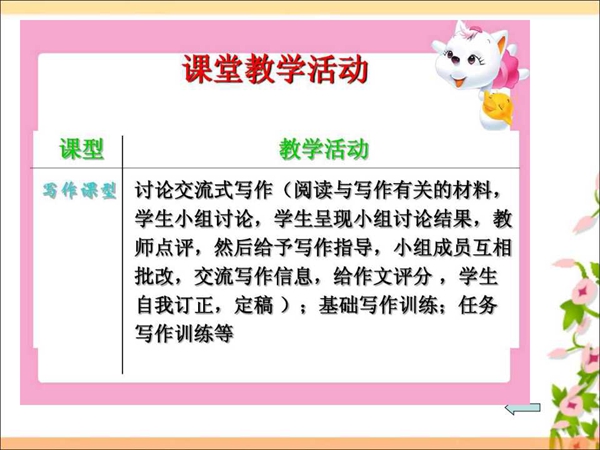
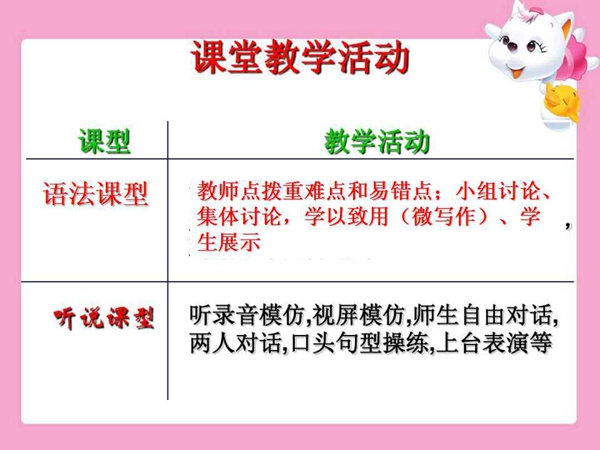
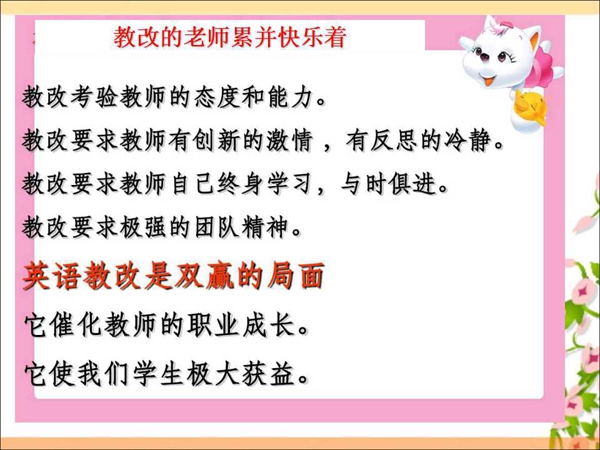
三、课件链接
学习、教学、分享
四、经验分享
完善课堂英语语言
刘文风
课堂语言是一门艺术,要想这门艺术给人以美的享受,教师要有过硬的综合素质,其中课堂语言就是教师最重要的基本素质之一。一节优质的课堂,教法的灵活选择、课件的精心制作、活动的精彩呈现、环节的衔接及完整确实非常重要,但要达到课堂教学的效果,课堂语言的表现力如何还是至关重要的,它是一个教师从事教学的起码条件,也是一个优秀教师的最基本素质。
一、 英语课堂语言的重要性
随着新课程改革的实施和深入,众多教师将设计新颖的教学活动,巧妙的教学环节、漂亮的教学课件作为备课的核心,认为这些工作做好了,自然就能上一节精彩的好课。其实未必,如果英语课堂语言表现不当或英语语言的表现力差,再好的教学环节,再精彩的的教学活动,都难以收到良好的课堂效果。英语不同于其他学科,英语教师使用的课堂英语不但是一种传授知识和技能的工具,同时本身就是一种知识和技能,对学生有着示范作用和语言输入作用。但很多教师并没有真正认识到英语教学语言的重要性,课堂上英语课堂语言错误频发、发音不准、表达不清或干脆直接用汉语,如:1)不规范。准确性不够,如:时态语态不对,主谓不一致等。2)课堂用语太随意,不能贯穿始终。3)不用英语授课或半英半汉,如because 什么来…..;汉氏英语,如together answer….4)课堂英语单一: right/ good/ excellent/wonderful/well done/perfect/brilliant/a good job/
5)语音语调不准确:元音发音不到位,长短音不清晰:fill / feel;元音发音不饱满:fine/bike等等。基于此,为了提高课堂效率,教师在备课时要精心设计课堂语言,力求用简洁明了的英语指令,使学生获得清晰准确的概念;用生动有趣的英语表达,提高学生兴趣、改善课堂效果;用节奏性强、富有乐感的语音语调,增强课堂的表现力、感染力,尤其是课堂教学的三大块:导入语、串联语和结束语。
二、 引人入胜的导语
英语中有句俗语:Good beginning is half done. 良好的导入不仅能有效消除课前干扰、稳定学生情绪,尽快把注意力集中到学习上,还能激发学生学习兴趣,对教师来说,也有先声夺人之效。正因如此,大部分老师都比较注重课堂的导入,应用的方法灵活多样,课堂效果也比较好。值得注意的是,英语课堂导入的方法虽很多,如:直观导入法(幻灯片、投影仪、图片、短视频等);复习导入法(“温故而知新”) ;设问导入法(激发学生兴趣与思考);故事、游戏导入法等,但英语课堂导入语的技巧在于英语课堂语言要有针对性、启发性、感染性、趣味性,使看似随意的口头语言却能与教学内容密切相连,启发引导学生增强探究新知识的欲望。
教学案例:
孙寿勇老师他的导入和结束环节让我们印象深刻。(简评课堂语言:课堂语言简练、指令明确、事情交代的清清楚楚)在讲授B3,M5,Philosophers of Ancient China时,导入环节展示了2008 北京奥运会上一段万人击鼓的视频,视频场面恢弘,大气磅礴,令人震撼,热血偾张,很富有感染力。视频结束后,孙老师提问:What do you think of the performance? Or What words can you use to describe the performance? ( amusing / fantastic / great …), 接着转入了下一环节:Now , let’s see some famous teachings of the three philosophers. ……. 然后进入了新课。请思考:视频和本课有联系吗?可以说“有”也可以说“没有”,关键看怎么体现的!所以说,老师的课堂语言在此应该起“穿针引线”的作用,使导入顺理成章地进入课堂。同样是孙老师的课,在最后的结束环节做得就比较好。学完主课文,讨论三个哲学家的一些哲学观点时,孙老师的问题是:Of the three philosophers, which do you like best? Why? 讨论后,学生回答积极,也有不少的新思想出现,孙老师重点概括出了两点:Love / duty,(有图片、文字)并引出了汶川地震人们表现出的大爱,四川森林大火牺牲的消防队员展示出的责任担当与对国家的爱、对人民的爱等等。这种情感目标的提升因为有了老师课堂语言对内线的牵引,感觉就比较自然。
三、 承上启下的串联语
一节优质的课堂应该是一起呵成,如行云流水般的。各教学环节应该是有一条内在的主线串联,由教师的过渡语言呈现,使各教学环节自然衔接(问题:1.缺少必要的过渡语言,只是按照课件设计的片子一张张讲解,像是一个各教学环节的大拼盘;2过渡语言啰嗦、冗长,尤其是一些大长句,学生听的很累还不易明白;3.过渡语言使用不准确,偏离主线,使整堂课的效果打折扣;.…….)。教学串联语的巧妙运用最能显示教师驾驭课堂的能力。若教学环节缺少串联语,或设计不当,表达模糊,各环节就会显得孤立、凌乱,主题目标不明确,很难达到预期效果。另外,英语课堂教学串联语也是启发学生思维、引导学生向更深处探索的阶梯。所以教师应该重视串联语的设计,为每个环节的过渡,每个活动的展开做好铺垫,用一条“暗线”串活英语课堂,使课堂层层递进、环环相扣,脉络清晰,一气呵成。让学生随着老师的节奏有缓有急,跟着老师的情绪有高有低,轻松愉悦地学习英语。
例如,设问法是课堂进展过程中,教师常用的一种推进课堂的方法。以提问入手,容易激起学生的学习兴趣和求知欲,也能反馈学生对所学知识的理解。但要注意的是提问问题的深度,尽量不问一些明知故问(如一般疑问句的句子)或没有思维含量的问题。
案例1:
有老师在教授外研版必修一Module4,有关厦门的一课时,老师展示了很多有关厦门的一些华丽图片,然后问:Is Xiamen beautiful? Do you want to go there?... Ok, let’s learn something about Xiamen/ Let’s have a travel to Xiamen.
请比较:
Teacher: After enjoying the beautiful scene of Xiamen, I’m sure most of us want to go there to have a real look of Xiamen. Right? Then what do you really want to go there for ? …..
Students: 1)To see the high-rise buildings, the splendid downtown and the gorges island ----Gulangyu island;
2)To taste the delicious food ;
3) to go to Xiamen University.
刘老师自己使用的案例2:外研版必修四,Module3 “The Human Traffic Signal”,本课讲的是“人体交通标志”。本节课教学任务是帮助学生学习与职业有关的、描述职业特点的词汇。在学习完主课文“The Human Traffic Signal”后的讨论、提升环节,我提出了如下问题:1、What job do you like to do? Why?(你所喜欢的职业是什么?为什么?)。2、Now Timoteo is very old, If You were his son, would you take over his career and act as a Human traffic signal? Why? What other ways can you use to help solve the problem? (可运用所学物理学知识)。
设计这两个问题,目的有两个:一是使学生能运用本堂课所学词汇及表达方式来描述某种职业;二是想了解学生的价值取向,实现本课的情感目标:倡导学生要有奉献精神,同时要有科学精神,学以致用。
小组代表展示(略)后的反思:1、有关职业的思考学生表现得很积极,热烈讨论、认真思考、积极抢答发表自己的观点,引出了很多有价值、有深度的思考并引起了共鸣,效果非常好;2、对两个问题的讨论后的展示有两点值得我们思考:第一点,对未来的职业,学生的回答有软件/服装/园林设计师、游戏解说员、品尝师(品酒师、水果品尝师)、商人、自由职业者,公务员、教师、甚至网红等等,原因多种多样,但没有一人想当工人、农民、清洁工、建筑工人等体力劳动者,为什么?我在思考,是不是我们的教育、社会舆论的导向出现了问题,使我们的学生价值取向有了偏差。第二点,对于如何解决“人体交通标志”的问题,同学们给出的方案是“设交通灯;政府想办法解决;拓宽盘山公路;子承父业,儿子继续充当‘人体交通标志’”等等,只有一位同学在我的反复启发下,想到了运用物理学上凸透镜的原理设置一面镜子来指导交通车辆。由此不难看出,有些学生只一门心思钻到了书本里,不观察生活,缺少常识,更不能学以致用。这两个问题的设计与探讨,既训练了学生的思维品质,又完成了对学生情感目标的提升。
第二点,设问的时机要把握好,只有当学生“心求之而未知,口欲言而不能”的时候,提出问题进行启发,才能收到良好的效果;或当学生的思维处于“山重水复疑无路”时提问,通过学生解答,使学生有“柳暗花明又一村”之感;也可以当学生注意力不集中、心不在焉时提问,收到“一石激起千层浪” 的效果。
四、 回味无穷的结束语
课堂结束语虽三言两语,但同样不可轻视。“编筐编篓,全在收口”,好的结束语既能总结概括本节课的知识精髓,又能起画龙点睛、提炼升华之作用,还可适当融入思想品德教育,达成情感教育之目标。
案例1、外研版必修一Module2, My New Teachers 本课描述了三个不同教学风格的老师,无论是导入环节还是课后讨论环节,老师们一般都会让学生用一些形容词或英语表达描述学生心目中“好老师和坏老师”的标准,我在教授本课时把该环节放在了后面,而且在学生情绪高涨地讲述完这些标准后,我又提出了下面的问题:In your opinion, what qualities should a good student have ? or do you want to know what students are good students in the teachers’ eyes? 这一下,好多学生傻了眼。只有部分学生说出了:to have good scores; smart; beautiful / handsome; hard work; …. 接着,我向学生提出了我心目中好学生的标准: to be kind / tolerant / honest /polite/ friendly ; to be active in class; hard work; ready to help each other; to have good scores; … 通过这节课,我想让学生在刚进入高中就明白, 作为一名学生,应该怎么做。
案例2: 好的结束语再加上其他有特点的辅助手段,会使人印象更深刻,亮点更突出。比如借助简笔画(张辉老师说课比赛时,最后总结部分采用的蝴蝶图案;前些年暑假培训时,新峰老师设计的“高中英语第一课”的大树的图案;丛笑老师的“English is a bridge”,都非常精彩,很吸引人);再如,朱琳老师省里优质课比赛时最后简练的语言+漂亮的板书,为她提分不少。
好的结束语如同钟声,响亮惊醒又余音缭绕,使听课人印象深刻、回味无穷。当然,课堂结束语形式多样,要因时制宜,因课制宜,不可刻意强求,更无需劳神费力去表演。
总之,课堂教学是一门艺术,英语课堂语言更是一个英语教师基本素质的体现。课堂上,学生对英语语言的体会和感悟一方面来自教师教授的英语知识,另一方面来自教师的课堂英语语言。英语教师的课堂语言尽量做到简短化、体态化、韵律化、适当配合母语化。所以,学习、研究、精心设计、用心训练英语课堂语言是每个英语教师的一门必修课。
附:55句超实用的英语课堂教学用语
1、 Who wants to try? 谁来试试?
Any volunteers?
2、Come up to the front, please. 请到前面来。
3、Go back to your seat, please. 请回座位。
4、Come on. You can do it. 来吧!你能做到的。
5、Come on, you’re almost there. 来吧!你快(做/答)对了。
6、I’ll give you a clue (hint). 我给你一些提示。
7、Now work in pairs/groups. 请大家做对子/小组练习。
8、You can do it this way. 你可以这样来做。
9、Let’s play a game. 让我们玩个游戏。
10、Are you tired? Let’s take a break. 累了吗?休息一下。
11、Look up the word in the dictionary. 在字典里查这个词。
12、Take notes, please. 请作笔记。
13、Are you clear? 明白了吗?
Can you follow me? / Do you understand? / Is that clear?
14、Is that right /correct? 那个正确吗?
15、Can you find the mistakes? 你能找出错误吗?
16、Don’t copy others’ work. 不要抄别人的作业。
17、Follow me, please.
18. How to pronounce the word?
Pay attention to your pronunciation / spelling/ grammar.
19、Do you know how to correct the mistakes? 你知道怎么改错吗?
20、Are you ready? 准备好了吗?
21、Can you guess it? 能猜猜吗?
22、Yes. You’re right. 对,你对了。
23、I’m sorry. Can you say that again? 对不起,能再说一遍吗?
24、Take your time. 慢慢来。
25、Use your head. 动动脑筋。
26、Good idea! That makes sense. 好主意。有道理。
27、Whose turn is it? 轮到谁了?
28、Now you’re going to read one by one. 现在你们依次朗读。
29、Who’s next? 接下来是谁?
30、You’re next. 接下来是你。
31、It’s your turn. 轮到你了。
32、Just hands. No voices. 不要说,请举手。
33、Do it on your own. 自己做。
34、From the very beginning. 从头开始。
35、Please read it to the end. 请读到结尾。
36、Come to my office after class. 下课后到办公室找我。
37、Stop here, please. 请停下来。
38、Hands up before you answer. 回答问题前,请举手。
39、Here’s your homework for today. 这是今天的家庭作业。
40、Hand in your homework tomorrow. 家庭作业明天交。
41、Please pass the exercise books to the front. 请将练习本递到前面来。
42、Who wants to come to the front? 谁愿意到前面来?
43、Come to my office after class. 下课后到办公室找我。
44、Come and see me after class. 课后找我。
45、Watch me and I'll show you. 看着我,我来演示。
46、I want all of you to answer this question. 我请大家一齐来回答这个问题。
47、That’s all for the new lesson/ revision. 新课/复习就到这儿。
48、I want you to work in pairs/groups. 请大家做对子/小组练习。
49、I’m sorry to have kept you so long. 对不起耽搁大家了。
50、That’s all for today. 今天就到这
51、We stop here for today. 今天就到这。
52、Let’s call it a day. 今天就到这。
53、Don’t copy others’ work. 不要抄别人的作业。
54、Class is over. Thank you, class. 下课。谢谢!
55、Good-bye./ See you tomorrow. 再见/明天。
Time is up.
Once more, please.
In pairs / groups, please.
高中英语课堂教学用语
王秀芹
1 上课(Beginning a class)
(1)Let s start now / Let s begin our class / lesson
(2)Stand up, please
(3)Sit down, please
2 问候(Greeting)
(4)Hello, boys and girls / children
(5)Good morning, class / everyone / everybody / children / boys and girls (6)Good afternoon, class / everyone / everybody / boys and girl s
(7)How are you today?
3 考勤(Checking attendance)
(8)Who s on duty today? / Who s helping this morning / today ?
(9)Is everyone / everybody here / present?
(10)Is anyone away? / Is anybody away?
(11)Is anyone absent? / Is anybody absent?
(12)Who s absent? / Who s away?
(13)Where is he / she?
(14)Try to be on time / Don t be late next time
(15)Go back to your seat, please
(16)What day is it today?
(17)What’ s the date today?
(18)What’ s the weather like today?
(19)What s it like outside?
4 宣布(Announcing)
(20)Let s start working / Let s begin / start a new lesson / Let s begin / start our lesson
(21) First, let s review / do some review
(22) What did we learn in the last lesson?
(23) Who can tell / remember what we did in the last lesson / yesterday?
(24) Now we re going to do something new / different / Now let’s learn something new
(25) We have some new words / sentences
5 提起注意(Directing attention)
(26) Ready? / Are you ready?
(27) Did you get there? / Do you understand?
(28) Is that clear?
(29) Any volunteers?
(30) Do you know what to do?
(31) Be quiet, please / Quiet, please
(32) Listen, please
(33) Listen carefully, please
(34) Listen to the tape recorder / the recording
(35) Look carefully, please (36) Look over here
(37) Watch carefully
(38) Are your watching?
(39) Please look at the blackboard / picture / map
(40) Pay attention to your spelling / pronunciation
6 课堂活动(Classroom activities)
(41) Start! / Start now
(42) Everybody together / All together
(43) Practise in a group / Practise in groups / In groups, please
(44) Get into groups of three / four
(45) Everybody find a partner / friend
(46) In pairs, please
(47) One at a time / Let s do it one by one
(48) Now yo u, please / Your turn ( Student’s name).
(49) Next, please Now you do the same, please
(50) Let s act / Let s act out / do the dialogue
(51) Who wants to be A?
(52) Practise the dialogue, please
(53) Now Tom will be A, and the other half will be B
(54) Please take (play) the part of
(55) Whose turn is it?
(56) It s your turn
(57) Wait your turn, please
(58) Stand in line / Line up
(59) One by one / One at a time, please
(60) In twos / In pairs
(61) Don t speak out
(62) Turn around
7 请求(Request)
(63) Could you please try it again?
(64) Could you please try the next one?
(65) Will you please help me?
8 鼓励(Encouraging)
(66) Can you try?
(67) Try, please
(68) Try your best / Do your best
(69) Think it over and try again
(70) Don t be afraid / shy
9 指令(Issuing a command)
(71) Say / Read after me, please
(72) Follow me, please
(73) Do what I do
(74) Repeat, please / Repeat after me
(75) Once more, please / One more time, please
(76) Come here, please
(77) Please come to the front / Come up and write on the blackboard
(78) Come and write it on the blackboard
(79) Please go back to your seat
(80) In English, please
(81) Put your hand up, please Raise your hand, please
(82) Put your hands down, please / Hands down, please
(83) Say it / Write it in Chinese / English
(84) Please take out your books
(85) Please open your books at page / Find page / Turn to page
(86) Please answer the question / questions / Please answer my question(s ).
(87) Please read this letter / word / sentence out loud / Please read out this
letter / word / sentence
(88) Please stop now / Stop now, please / Stop here, please
(89) Clean up your desk / the classroom, please
(90) It ‘s clean up time / Tidy up your desk / the classroom
(108) That s not quite right, any other answers? / That s close / That s almost right
11 布置作业(Setting homework)
(109) For today s homework
(110) Practise after class / Practise at home
(111) Say it out loud, before you write it down
(112) Copy / Print / Write each word twice
(113) Remember (Memorize) these words / sentences
(114) Learn these words / these sentences / this text by heart
12.评价A.肯定1. Good, thank you / Good job / Good work / Good example
2.Well done.
3.Absolutely right.
4.Definitely correct
5.Right to the point.
6.Very good/ Excellent / Great! / Well done / I like the way you
7.Terrific.
8.Fabulous.
9.Exactly.
10.Congratulations.
11.Good effort
12.Nice job/ Nice work.
13. Good answer
14.What an example!
15. Creative ideas.
16.Congratulations.
17.Amazing answer. It is beyond my expectation.
18. High five.
19.Low five.
20. You never make people disappointed.
21. You’ve hit the point.
22. That s interesting!
23. Don t worry about it / No problem
B. 部分肯定
1.You are reasonable, but you need a complete answer.
2.It’s much closer to the right answer.
3. Almost , but change another standing point.
4.A little bit closer , but think of the …
5.You are creative. I suppose you can’t tell what you are thinking about.
6.You are around the point, but go straight ahead. There is a short cut.
7.Let’s collect all the different ideas an d then it might be clearer.
8.Your own viewpoint, isn’t it? Let’s see what the other people are thinking about.
9. You need a further discussion after class.
11. I don t think so
12. That s not quite right, any other answers? / That s close / That s almost right
13. Not quite right, can anyone help him / her? / Try again
14. A good try
|
